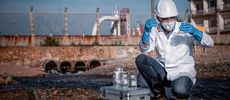Does Sulfur Bacteria in Water Make it Unsafe to Drink?


When someone smells rotten eggs after turning on the tap, they may decide they don't need a drink or a shower after all, even if they're told the water is safe. Combine that with yellow or red stains in the sink or tub, and they may really begin to worry about water quality. The signs could mean nothing—or point to something more serious.
Chances are the source of these issues is hydrogen sulfide gas produced by bacteria in water, but more than one kind of bacteria can be responsible. Sulfur-reducing bacteria are generally naturally occurring and harmless. But bacteria from decomposing organic material, like sewage or pollution, can be far more treacherous—with impacts ranging from mild dehydration to diarrhea to serious gastrointestinal distress.
The situation calls for testing by a reputable water quality lab to ensure water is safe for drinking, cooking, and bathing. Here's a closer look at sulfur and other culprits in a water system that all smell similar.
Sources of a Rotten Egg Smell in Water
Rain and groundwater seep through the earth and into reservoirs far below the surface. On the way, the water dissolves oxidized sulfide ores and other sulfur-containing minerals, releasing sulfates into the groundwater.
Bacteria living in the soil snack on sulfur for energy, using it as a food source. The bacteria then produce hydrogen sulfide gas, which causes a noxious smell in water. In addition to infiltrating well water and groundwater, hydrogen sulfide gas can also result from chemical reactions in plumbing systems or water heaters.
Water with high sulfate levels can also have a bitter or medicinal taste and possibly a laxative effect on people, particularly infants unaccustomed or sensitive to it. The EPA estimates that about 3% of U.S. public drinking water systems may have sulfate levels of 250 mg/L or greater, which is above the recommended aesthetic limits for taste and odor and for health.
Sulfur Bacteria vs. E. Coli
Sulfur bacteria in water is usually harmless to humans. Still, people may have to deal with other unwanted effects such as tarnish on silverware and metal plumbing fixtures, corroded metal piping in the water system, and slime that can clog pipes, wells, and irrigation systems. The slime also makes it easier for other microorganisms to grow, such as iron bacteria or more harmful types like E. coli.
If the rotten egg smell stems from sewage or pollution in a water system, the problem becomes more critical. For this reason, well water should be tested at least once a year for total coliform bacteria and E. coli. These can cause digestive system upsets, including dehydration and stomach cramps, or more serious conditions, including bloody diarrhea and vomiting. Although rare, it's best to test any water that smells bad for contaminants and not find out the hard way that it's unhealthy.
Tracking and Testing for Sulfur in Water
How can you pinpoint the source of a rotten egg smell? A flow chart from the Minnesota Department of Health looks at various possibilities from water heaters, water softeners, well and plumbing systems, and groundwater.
Depending on the sulfur's source, treatment options include replacing specific water fixtures, repairing a water heater, and carbon filtration, aeration, or shock chlorination to kill the sulfur-producing bacteria. Determining the treatment that will work best also requires a test to measure the hydrogen sulfide level in the water.
Private well owners should also test every year for E. coli and nitrate, at least once for arsenic and lead, and before a new baby drinks the water for manganese. Numerous filtration systems can help remove harmful contaminants from water, in addition to making it far more pleasant to smell and drink.






